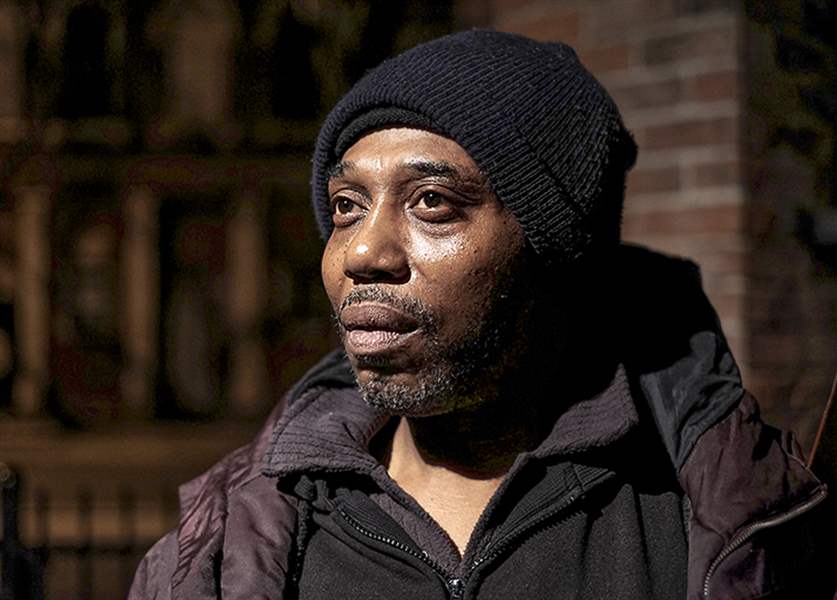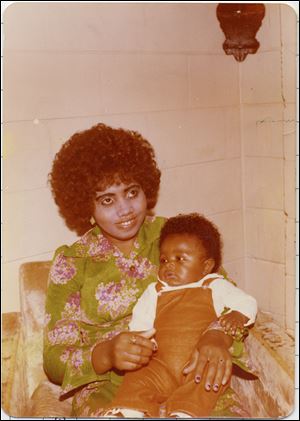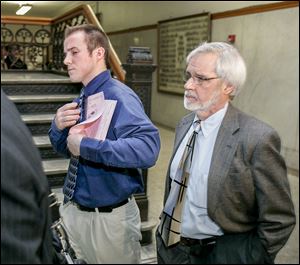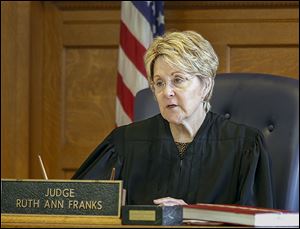
COMMENTARY
Justice, the law, and Danny Brown
Horror is avenged — the crime and trial
1/18/2015
Danny Brown was sentenced to life in prison for aggravated robbery and aggravated murder in the slaying of Bobbie Russell. Based on DNA evidence, he was released from prison in 2001.
THE BLADE/JEREMY WADSWORTH
Buy This Image

First of three parts
On Dec. 5, 1981, Bobbie Russell, a single mother of three, was murdered in Birmingham Terrace in Toledo. The crime was horrific. Ms. Russell was clubbed in the head. She was raped. She was strangled to death with an extension cord, to which was attached the club, used as a garrote. The rape, police and coroner speculated, may have occurred simultaneous to the strangulation, or after it. In addition to all this, a broom handle had been rammed into her vagina with great force, perforating her female organs.
It is very hard to think of this crime, impossible to fathom it, and totally impossible to take in the torture Bobbie Russell endured.
And what are we to make of the heart and mind, if they can be called that, of the person who did these things to her?
The horror compounds. Ms. Russell’s three children were in the house when all this occurred. Two little baby girls — twins Sheila and Sandy, age 2 — slept. A boy Jeffrey, 6, was awakened and heard and saw, well, we don’t know exactly what. Certainly too much for any one human life to bear.

Danny Brown was sentenced to life in prison for aggravated robbery and aggravated murder in the slaying of Bobbie Russell. Based on DNA evidence, he was released from prison in 2001.
Before he left Bobbie Russell’s apartment, and her body lying on the living room floor, the killer went to the second floor, where he placed a hanger around Sandy’s neck and punched the little girl in the mouth. He then turned on the gas burners on the kitchen stove and departed with an old TV and an older stereo that no longer worked and was discarded in the snow.
The trial
What precisely, and how much, Jeffrey saw probably even he does not know, and therein lies the continuing mystery at the heart of this barbarous killing.
But the crime cried out for justice. It had to be avenged.
Almost a year after this brutal slaying, a Toledo jury convicted Danny Brown, an unemployed Army vet, of the crime. Brown had recently been an intermittent and probably nonexclusive lover of Bobbie Russell’s.
The trial was a drama in its own right. It featured a righteous, brilliant, and relentless inquisitor, assistant county prosecutor Ruth Ann Franks, who is now a judge. She had outrage at her back. An equally gifted defense attorney represented Brown. Jon Richardson was a former English teacher fond of Shakespeare and jazz. He has gone on to a distinguished career at the criminal bar. Finally, there was the judge — the late Francis Pietrykowski, who was not equal to the enormity and brutality of the case. At least that is my reading of the transcript.
What a trial. The accused’s brother brought a switchblade to court on the last day and was arrested. The defendant’s best friend, suspected by the police and prosecutor at the time of being a possible abettor to the crime, was said to have murmured a threat to the prosecutor, who then brought a uniformed police officer with her to court. The defense asked for a mistrial based on all this. Denied. Mr. Richardson began his closing statement and got dizzy and sick — paramedics were summoned and a recess called. That’s the kind of trial it was. The BBC could make a riveting five-part drama of it.
But, in the end, Danny Brown was convicted of aggravated robbery and aggravated murder and sentenced to life in prison.
End of story, right?
Wrong.
Key witness
First, Brown’s conviction was based, almost solely, on the testimony of young Jeffrey. There was, substantially, no physical evidence — only one clear print, a palm, and it was not Danny’s. Yet Jeffrey said, from the start, that Danny did it. He said he saw him hurting his mother. He never wavered in this. He believes it to this day.
The problem is that Jeffrey told several versions of what he saw — a stabbing that never occurred; the assailant breaking a leg off a table or maybe a chair though no table or chair was missing a leg; seeing the assailant take down the coat hanger and place it around his sister’s head, though Jeffrey Russell also testified that he was hiding under a bed with his eyes to the wall at the time. And, in one version of what he recalled, he said he may have seen two men.

Bobbie Russell is shown with her son, Jeffrey, who was 1 year old at that time. At the age of 6, Jeffrey witnessed the brutal assault and slaying of his mother. His testimony played a major role in the conviction of Danny Brown.
The only consistent elements in his various narratives were that he had seen Danny come to the front and back doors from front and back windows; that he had come partway down the stairs and peeked, and that he was sure the assailant was Danny.
The two-man memory/theory was seized upon by the defense in the trial.
Today, it is the state that clings to it.
But Jeffrey Russell’s story was a mess. Mr. Richardson said there were at least three complete and distinct versions. Judge Pietrykowski, who seldom ruled for the defense in this trial, told the court that Jeffrey’s testimony was “glaringly inconsistent.” What Jeffrey told police investigators, the grand jury, and the trial court simply didn’t align.
Judge Pietrykowski’s first great mistake, according to a dissent written by state appeals Judge Peter Handwork, when the case was appealed by Brown, was that he did not underline this inconsistency to the jury, either in his charge or, even more important, by allowing the jury to compare Jeffrey’s grand jury and trial testimony. A jury, Judge Handwork reiterated to me in an interview, is entitled to all the information that exists and is relevant.
His dissent was eloquent and the judge feels, to this day, that the trial was not a fair one. He wrote that, even after competence to testify is established, as it was for Jeffrey, the trial court has an obligation to continue to monitor the competence of particular testimony by a minor. The grand jury transcripts of Jeffrey Russell’s testimony would have enlightened the jury as to the depths of the boy’s contradictions and confusion.
Ms. Franks argued, persuasively, in the trial that children see things differently than we do and reconstruct what they have seen differently, but they are still innocent beings and thus essentially truthful. The bottom line, she said, was that Jeffrey saw Danny that night and knew that he did.
But innocence and veracity are not necessarily mutually reinforcing. And the reconstruction of memory is indeed key to a case like this one.
Eyewitness accounts
Even a cursory glance at scholarship on the subject shows that children are easily led by authority figures in storytelling, and this has led to famous cases of false accusations and recantations in child-abuse cases. In England, in fact, there has been a rethinking of child interviewing techniques for social workers and police officers. The consensus is that authority figures can unintentionally foster manufactured memories and encourage kids to fantasize.

During the trial, defense lawyer Jon Richardson argued that Jeffrey Russell’s story of his mother’s slaying had three complete and distinct versions.
Judge Handwork felt that Jeffrey may well have been led, which may partially account for the different versions of what he said he saw.
Writing in the Canadian Journal of Police and Security Services, scholar Carole Peterson states: “It is undeniable, however, that children are vulnerable to suggestion, coercion, and a host of poor interviewing techniques. Thus, it is extremely important for interviewers to be well-trained and to use techniques that have been shown to be appropriate for children.”
Actually, the current direction of science on eyewitness testimony is toward a blanket skepticism. The memories of ALL human beings, not just children, must be taken with a grain of salt.
Forensic psychologist Scott Fraser, based in Los Angeles, studies how human beings remember crime. The short answer, for all ages, is: not very well. He says “all memories are reconstructed memories” and that we should keep this constantly in mind, both in life and in law. The reason, he says, is that the brain “abhors a vacuum.” We fill in the blanks with imagined ancillary sights and events. The mind needs to fill out the narrative. And, he adds, how vivid or how sure the memory is has nothing, nothing, to do with its accuracy. I commend to the reader this fascinating Ted Talk by Mr. Fraser in which he recounts the conviction and imprisonment of a man — also for 20 years — for murder, based on six eyewitnesses: http://tinyurl.com/mo8rgeb.
Six eyewitnesses. Mr. Fraser proved, technically and scientifically — by researching time and weather and re-creating the scene photographically and then in a physical, on-site re-enactment — that the six eyewitnesses could not have seen what they were sure they saw. In this case, the convicted man was released and exonerated.
Three-fourths of exonerations in America achieved by DNA were of convictions based on eyewitness accounts. This is certainly counterintuitive, but it is truth.
A flawed witness?
Jeffrey was, and remains, sure about what he saw. That doesn’t make his memory accurate.
The little boy certainly had courage. When Jeffrey picked Danny out of a lineup, all those years ago, he called Danny the killer in his presence. Danny cried out, “Why are you lying?” and the boy said, “No Danny, you’re lying.”

Now a Lucas County Common Pleas judge, Ruth Ann Franks prosecuted the case against Danny Brown. During the dramatic trial, she argued that children are innocent beings and thus essentially truthful.
During the trial, Mr. Richardson argued that Jeffrey might have a problem distinguishing reality from imagination, especially given the trauma caused by what he saw and heard. But Mr. Richardson’s practical problem, as a defense lawyer, was that he could hardly attack the inconsistencies of a little boy who had been through what Jeffrey had been through — not with the ferocity with which he would have attacked a similarly confused adult witness.
The judge should have stepped in here. His failure to caution the jury in detail about the contradictions, in the only real evidence presented, fundamentally compromised the fairness of the trial.
Indeed, in some states, a child of 6 may not testify at all. Seven is usually considered the earliest age at which children can understand factual truth. Jeffrey had been ruled competent to testify, but he was far from coherent and consistent — he was too young and had been through an ordeal no 6-year-old could possibly process.
‘Bad nerves’
In his dissent, Judge Handwork pointed out a second error in the trial. It was that the judge allowed the prosecutor to explore Danny Brown’s mental state. The basis for this was that Brown was said to have had “bad nerves.” He got the shakes. He still gets them. Over Mr. Richardson’s objection, the judge allowed the prosecutor to explore this line, including with Brown himself on the stand. Judge Handwork wrote that this was totally inappropriate and also made the trial unfair. He cautioned future trial lawyers not to attempt to link such things as bad nerves or shaking with mental instability and/or criminal guilt. But this questionable tactic was allowed and was effective.
Moreover, Ms. Franks managed to unnerve Danny Brown on the stand and make him look not quite right, as well as evasive and hostile. She repeatedly called him “weird” during the trial. And this one-two-three punch — weird, nervous on the stand, and a history of bad nerves — worked.
Of course there are many slightly off-center or even downright unstable people in this world. Few of them are capable of a murder so gruesome and heartless.
But Ms. Franks also had decimated Danny’s alibi for the time of the murder — by showing that the testimony of various friends who said they were with him was contradictory and by showing that his father, who testified that he remembered Danny’s presence because he was preparing to go to work that night, had not gone to work that night. Mr. Richardson’s hands, meanwhile, were tied. He could not do to the state’s key witness what the state did to Danny on the stand. Mr. Richardson told me: “Jeffrey was the cutest kid you ever saw in your life — a lovable, beautiful kid.”
And a living victim.
So, a dramatic and less-than-fair trial, but a compelling star witness, and a crime that had to be answered.
“Weird” Danny Brown went to prison for life. He went from prison to prison learning more and more about the law and going over and over his trial. And then, almost 20 years later, something happened: DNA.
And in 2001, Danny Brown was released from prison.
They got the wrong man.
End of story, right?
Wrong.
Not nearly the end.
Keith C. Burris is a columnist for The Blade.
Contact him at: kburris@theblade.com or 419-724-6266.